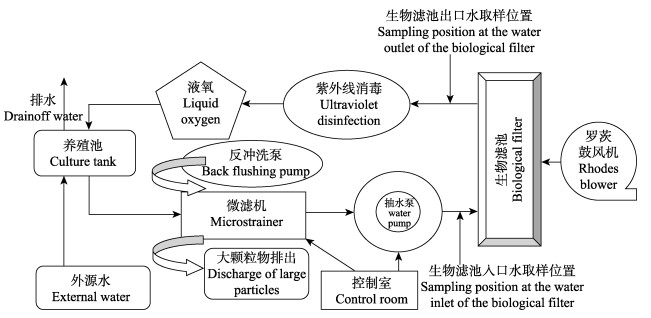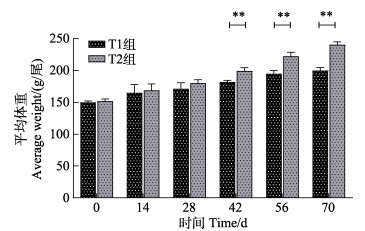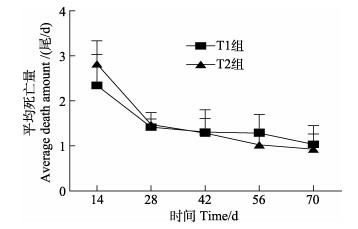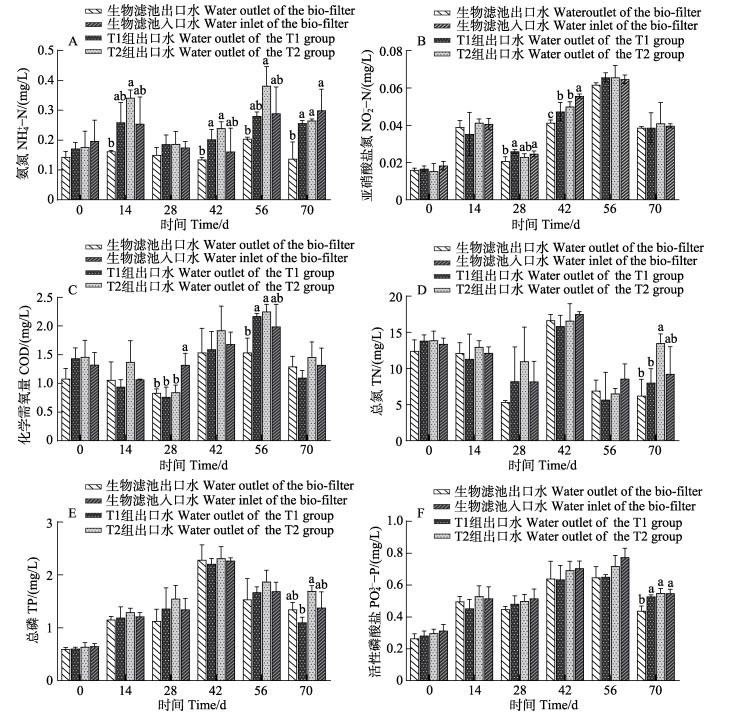2. 中国水产科学研究院黄海水产研究所 农业农村部海洋渔业与可持续发展重点实验室 海洋渔业科学与食物产出过程功能实验室 山东 青岛 266071;
3. 海阳市黄海水产有限公司 山东 烟台 265100
2. Laboratory for Marine Fisheries Science and Food Production Processes, Key Laboratory of Marine Fisheries and Sustainable Development, Ministry of Agriculture and Rural Affairs, Yellow Sea Fisheries Research Institute, Chinese Academy of Fishery Sciences, Qingdao 266071, China;
3. Haiyang Yellow Sea Fisheries Co., Ltd, Yantai 265100, China
工厂化循环水养殖模式是一种将养殖用水分别经过物理、化学和生物方法处理后重复利用的新型养殖模式,可将一系列关键水质指标调节至水产动物适宜的生长水平,以其节水节能、高效可控等特点而成为现代化水产养殖业发展的主要方向之一(刘洋, 2022; 许思璇等, 2022)。循环水养殖系统水体中氨氮、亚硝酸盐氮等主要由残饵及粪便分解产生(Hamed et al, 2021),此类物质的去除主要依靠循环水系统生物滤池中生物膜的作用(侯明华等, 2020; 宫晗等, 2022)。此外,投喂大量高蛋白饲料会引起水体化学需氧量、总氮和总磷等环境指标偏高(张凯等, 2022)。通过对循环水水质检测与调控可以给水产动物提供舒适的水域环境,促进其生长,还可以检测生物滤池对各项水质的处理效果。为使已建成的循环水养殖系统发挥更大的效能,亟需研发与系统相匹配的高效养殖技术。
投喂频率是影响养殖鱼类生长的主要因素之一,也是鱼类养殖管理的中心环节(管敏等, 2021)。投喂频率过低会使水产动物生长缓慢、个体差异大以及对病原体的免疫力下降;投喂频率过低还会对鱼类造成不同程度的饥饿胁迫,导致氧自由基大量产生,损伤组织或器官(管敏等, 2021)。当投喂频率过高或投喂间隔过短时,会增加鱼类能量消耗并降低其对食物的消化吸收率,最终影响鱼类生长(Wu et al, 2015)。投喂频率过高还会浪费饵料、破坏水质、污染环境(谢苏明等, 2020; 吕云云, 2022)。适宜的投喂频率可以改善鱼类的摄食率并增加其生长速度,还可以降低循环水养殖系统水体中氨氮类等有毒物质的含量,提高鱼类存活率(潘伟平等, 2020)。所以,探究水产动物最适的投喂频率对于促进养殖动物生长、降低饲料成本,进而提高养殖效益具有重要意义。确定水产动物适宜的投喂频率要综合考虑其食性、规格、养殖系统、生长环境等影响因素(李卓钦等, 2018)。近年来,学者从消化酶活性、免疫指标、基因表达丰度等角度研究了史氏鲟(Acipenser schrenckii)(管敏等, 2021)、半滑舌鳎(Cynoglossus semilaevis)(柳阳等, 2015)、牙鲆(Paralichthys olivaceus)(陈小傲等, 2021; KüçüK et al, 2014)等鱼类的适宜投喂频率。
星康吉鳗(Conger myriaster)属于鳗鲡目(Anguilliformes),康吉鳗科(Congridae),康吉鳗属(Conger),广泛分布于中国黄渤海及东海海域、日本北部和朝鲜附近海域(唐衍力等, 2010)。星康吉鳗营养丰富、肉质细腻,具有较高的食用和经济价值,在中国海鳗类产品加工出口中占重要地位(杨浩等, 2020)。目前尚无星康吉鳗工厂化循环水养殖相关研究的报道,而本研究在已建立的工厂化循环水系统中开展星康吉鳗养殖实验,旨在提高其养殖效率的前提下进行高效循环水养殖技术方面的探讨。本研究通过分析工厂化循环水养殖模式中不同投喂频率下星康吉鳗生长性能、生理指标及其水质变化规律,以期为工厂化循环水系统星康吉鳗养殖技术工艺的优化提供理论支撑。
1 材料与方法 1.1 实验地点与材料本研究在山东省海阳市黄海水产有限公司循环水养殖车间开展。实验用星康吉鳗苗为同一批次野生苗种,已在循环水养殖车间养殖6个月。实验用鱼在循环水车间内经过预实验驯养2周后,选取个体大小相近、健康活泼的星康吉鳗进行实验,平均体重为(150.64±5.43) g。饵料为冰鲜玉筋鱼(Ammodytes personatus),冷冻保存。
1.2 工厂化循环水养殖系统采用工厂化循环水养殖生产系统,系统由24个养殖池、转鼓式微滤机(设有自动反冲洗泵)、抽水泵、生物滤池(滤料为化学纤维丝条加工而成的毛刷,滤池配备1台罗茨鼓风机)、紫外线消毒池和增氧池组成(图 1)。实验选用24个养殖池中的6个池作为取样池,实验总水体为760 m3左右;单个养殖池有效水体为25 m3左右,4个生物滤池有效水体共150 m3左右,紫外线消毒池、增氧池各1个,有效水体均为5 m3左右。实验期间24 h循环水率保持在10次以上,外源水每天补充量为总水体的10%左右。

|
图 1 星康吉鳗循环水养殖系统示意图 Fig.1 Process flow diagram of recirculating aquaculture system for C. myriaster |
实验按照投喂频率分别为1次/天(T1组)、2次/天(T2组),实验周期为70 d。各设置3个重复,每个养殖池放养星康吉鳗重量约为150 kg。T1组每天15:00投喂冰鲜玉筋鱼,T2组每天分别在15:00和20:00投喂冰鲜玉筋鱼。均为饱食投喂,投喂量根据实验期间实验鱼体重调整。
每天08:00捞出死鱼并称重记录,残饵、粪便推至中心排水管排出,每天换水量约为10%。投喂前测量水温并记录,24 h液氧供应,实验期间的相关条件:水温范围为21.9~23.8 ℃,氨氮 < 0.4 mg/L,亚硝酸盐氮 < 0.07 mg/L,pH维持在7.8~8.2,盐度为28~34,DO≥6 mg/L。
1.4 样品采集与保存 1.4.1 组织样品采集实验结束后,每个重复随机挑选2尾星康吉鳗,用MS-222 (200 mg/L)麻醉,称量鱼体重,测量体长、体高并记录。1 mL注射器尾静脉取血液,3 500 r/min (4 ℃)离心10 min后取上清液,于–80 ℃保存,用于血清抗氧化相关指标测定。冰上迅速解剖,取出内脏称重并记录。分离出完整的肝脏(称重)、肠道,后转移至–80 ℃冰箱保存,用于转氨酶、消化酶活性测定。
1.4.2 水质样品采集养殖周期水质变化取样:每14 d分别从生物滤池出口、T1组出口、T2组出口、生物滤池入口用高密度聚乙烯瓶取水样500 mL,采集时间为07:00,当天测定。24 h氨氮、亚硝酸盐氮变化取样:在实验第35天,每隔4 h分别从生物滤池出口、T1组出口、T2组出口取水样500 mL,当天测定。
1.5 测定指标与检测方法 1.5.1 生长指标测算解剖时用精度为0.1 cm的直尺测量鱼体高、体长,用精度为0.01 g的电子秤称量体重、肝脏、内脏重。每14 d测定一次养殖池内平均鱼体质量,每个重复至少取30尾。生长指标计算公式:
增重率(WGR, %)=100×(终末均重–初始均重)/初始均重
特定生长率(SGR, %/d)=100×(ln终末均重–ln初始均重)/实验天数
脏体比(VSI, %)=100×内脏重/体重
肝体比(HIS, %)=100×肝脏重/体重
肥满度(CF)=100×体重/体长3
成活率(SR, %)=100×终末鱼的尾数/初始鱼的尾数
饲料系数(FCR)=摄食量/(终末体重+总死亡量–初始体重)
1.5.2 生理指标测定采用南京建成试剂盒测定超氧化物歧化酶(T-SOD, A001-1-1)、过氧化氢酶(CAT, A007-1-1)、丙二醛(MDA,A003-1)、谷草转氨酶(AST, C010-1-1)、谷丙转氨酶(ALT, C009-1-1)、总蛋白(TP, A045-2-1)、淀粉酶(AMS, C016-1-1)、脂肪酶(LPS, A054-2-1)以及胰蛋白酶(TPS, A080-2-2),测定方法按照试剂盒说明书进行。
1.5.3 水质指标测定温度、pH、盐度和DO测定采用美国多参数水质测量仪测定(美国YSI集团);氨氮(NH4+-N)采用次溴酸盐氧化法测定;亚硝态氮(NO2–-N)采用磺胺–盐酸萘乙二胺分光光度法测定;化学需氧量(COD)采用碱性高锰酸钾法测定;总氮(TN)浓度采用碱性过硫酸钾消解紫外分光光度法进行测定;总磷(TP)浓度采用钼酸铵分光光度法进行测定;活性磷酸盐(PO43–-P)采用钼酸铵分光光度法测定。
1.6 数据处理数据采用IBM SPSS Statistics 25.0和Excel 2019软件处理,结果以“平均值±标准差”(Mean±SD)表示。生长和生理数据用独立样本T检验分析组间差异性(P < 0.05为差异显著)。水质数据采用单因素方差分析(one-way ANOVA)并采用LSD和Duncan法进行多重比较检验显著性(P < 0.05为差异显著)。
2 结果 2.1 投喂频率对工厂化循环水养殖星康吉鳗生长性能的影响T2组星康吉鳗的终末体重(FBW)、终末体长(FBL)、WGR和SGR均显著高于T1组(P < 0.05);T1组FCR显著高于T2组(P < 0.05)。终末体高(FBH)、HSI、VSI、CF和SR在2个实验组之间差异不显著(P > 0.05) (表 1)。2个实验组星康吉鳗平均体重在实验第0~28天间差异不显著(P > 0.05),第42~70天T2组极显著高于T1组(P < 0.01)(图 2)。2个实验组星康吉鳗平均死亡量均呈下降趋势,其中,T2组平均死亡量在第56天后低于T1组,但差异不显著(P > 0.05)(图 3)。
|
|
表 1 循环水系统中不同投喂频率下星康吉鳗的生长指标 Tab.1 Growth indices of C. myriaster under different feeding frequency in recirculating aquaculture systems |

|
图 2 循环水系统中不同投喂频率下星康吉鳗的平均体重变化 Fig.2 Changes of average weight of C. myriaster under different feeding frequency in recirculating aquaculture systems **代表差异极显著P < 0.01。 ** represents extremely significant difference P < 0.01). |

|
图 3 循环水系统中不同投喂频率下星康吉鳗的平均死亡量变化 Fig.3 Changes of average death amount of C. myriaster under different feeding frequency in recirculating aquaculture systems |
T1、T2组血清SOD、CAT活性差异不显著(P > 0.05),T2组血清MDA显著低于T1组(P < 0.05)(表 2)。T2组肝脏AST和ALT活性显著高于T1组(P < 0.05),T2组肠道TPS活性显著高于T1组(P < 0.05),肠道AMS、LPS活性2个实验组间差异不显著(P > 0.05)(表 2)。
|
|
表 2 循环水系统中不同投喂频率对星康吉鳗生理指标的影响 Tab.2 Effects of different feeding frequencies on physiological indices of C. myriaster in recirculating aquaculture systems |
NH4+-N、NO2–-N 24 h变化(图 4)中,TI组出口水与生物滤池出口水变化趋势更为相似,均为先下降再上升再下降。T1、T2组出口水2种指标分别有1处(24:00)和2处峰值(20:00、次日08:00)。在第1次投喂完后,T1组出口水达到峰值的时间点(24:00)较T2组出口水达到峰值的时间点(20:00)向后约4 h。在第2次投喂完后,T2组再次出现峰值(时间点为次日08:00)。NH4+-N 24 h变化如图 4A所示,T1、T2组出口水在24 h内差异不显著(P > 0.05),但均显著高于生物滤池出口水(P < 0.05)。NO2–-N 24 h变化情况如图 4B,T1、T2组出口水在24 h内尤其在投喂完后差异不显著(P > 0.05),生物滤池出口水在04:00与每日08:00显著低于其他2个实验组出口水(P < 0.05)。T2组NH4+-N、NO2–-N 24h变化幅度分别为0.06 mg/L和0.01 mg/L,均小于T1组。

|
图 4 循环水系统中不同投喂频率组出口水、生物滤池出口水的氨氮(NH4+-N)、亚硝酸盐(NO2–-N) 24 h变化情况 Fig.4 24 h changes of ammonia nitrogen (NH4+-N) and nitrite (NO2–-N) at outlet in different feeding frequency groups and outlet of the bio-filter in recirculating aquaculture systems A:氨氮NH4+-N;B:亚硝酸盐氮NO2–-N。不同字母表示差异显著(P < 0.05),下同。 A: Ammonia nitrogen NH4+-N; B: Nitrite NO2–-N. Different letters represent significant difference (P < 0.05), the same below. |
NH4+-N周期性变化如图 5A所示,整体趋势为先升再降再升再降,各取样点峰值均出现在实验第56天,生物滤池出口水、T1组出口水、T2组出口水、生物滤池入口水分别为0.20、0.28、0.38和0.29 mg/L,4处取样点各水质指标数值排列顺序不同。在实验第14、42、56和70天时,生物滤池出口水NH4+-N均显著低于T2组出口水(P < 0.05)。第42天时,T1、T2组出口水NH4+-N显著高于生物滤池出口水(P < 0.05)。第70天时,生物滤池出口水NH4+-N显著低于其余3处取样点(P < 0.05)。生物滤池对NH4+-N最低去除率为27.41% (第0天),最高为54.23% (第70天)。

|
图 5 循环水系统中不同投喂频率组出口水、生物滤池入/出口水的水质周期变化情况 Fig.5 Periodic changes of water quality at water outlet in different feeding frequency groups and inlet/outlet of the bio-filter in recirculating aquaculture systems A:氨氮NH4+-N;B:亚硝酸盐氮NO2–-N;C:化学需氧量COD;D:总氮TN;E:总磷TP;F:活性磷酸盐PO43–-P A: NH4+-N; B: NO2–-N; C: Chemical oxygen demand COD; D: Total nitrogen TN; E: Total phosphorus TP; F: Active phosphate PO43–-P |
NO2–-N周期变化如图 5B所示,整体趋势与NH4+-N较为相似,4处取样点峰值也均出现在实验第56天,分别为0.06、0.07、0.07和0.07 mg/L。第28天时,生物滤池出口水NO2–-N显著低于T1组出口水、生物滤池入口水(P < 0.05)。第42天时,生物滤池入口水NO2–-N显著高于其余3处取样点(P < 0.05),生物滤池出口水显著低于T1、T2组出口水(P < 0.05)。生物滤池对NO2–-N最低去除率为2.52%(第70天),最高为25.85% (第42天)。
COD周期性变化如图 5C所示,整体趋势为先降再升再降,4处峰值出现在实验第56天,分别为1.54、2.17、2.25和1.99 mg/L。生物滤池入口水COD在第28天时显著高于其余3处取样点(P < 0.05),生物滤池出口水在第56天时显著低于T1、T2组出口水(P < 0.05)。生物滤池对COD最低去除率为0.41% (第14天),最高为22.58% (第56天)。
TN周期性变化如图 5D所示,整体趋势为先降再升再降再升,4处峰值出现在实验第42天,分别为16.64、16.57、15.85和17.50 mg/L。实验第70天,T2组出口水TN显著高于生物滤池出口水和T1组出口水(P < 0.05)。生物滤池对TN最低去除率为0.18% (第14天),最高为34.70% (第28天)。
TP周期性变化如图 5E所示,整体趋势为先升再降,4处取样点在实验第42天时峰值分别为2.28、2.32、2.21和2.27 mg/L。在实验第70天时,T2组出口水TP显著高于T1组出口水(P < 0.05)。生物滤池对TP最低去除率为0.68% (第42天),最高为16.35% (第28天)。
PO43–-P周期性变化如图 5F所示,整体趋势也为先升再降,4处取样点在实验第56天时峰值分别为0.65、0.65、0.72和0.77 mg/L。第70天生物滤池出口水PO43–-P均显著低于其余3处(P < 0.05)。生物滤池对PO43–-P最低去除率为3.49% (第14天),最高为20.28% (第70天)。
3 讨论 3.1 投喂频率对工厂化循环水养殖星康吉鳗生长性能的影响研究表明,较高的投喂频率会加快鱼类能量消耗和胃肠道食物排空速率(Garg et al, 2018),本研究结合预实验以及工厂化循环水车间实际生产情况选用了2种适宜的投喂频率组进行初步探究。本研究中,T1组增重率(WGR)和特定生长率(SGR)显著低于T2组(P < 0.05),这与杂交鲷与黑鲷(Acanthopagrus schlegelii ♀ × Pagrus major ♂ and A. schlegelii)(仇玉燕等, 2022)、条纹锯
实验后期,2个实验组平均体重开始表现出显著性差异(图 2),这与谢苏明等(2021)在池塘工程化循环水养殖大口黑鲈(Micropterus salmoides)的结果相似。实验过程中各组平均死亡量呈下降趋势,原因可能是养殖期间各项水质指标均维持在安全养殖范围内,因此,未对实验鱼产生胁迫或负面影响(林艳等, 2015)。
3.2 投喂频率对工厂化循环水养殖星康吉鳗生理指标的影响在应激条件下,鱼类增强抗氧化防御机制,通过提高抗氧化酶的活性来对抗活性氧化物(Gao et al, 2022)。本研究中,SOD、CAT在2个实验组间差异不显著(P > 0.05),这与Gao等(2022)对红鳍东方鲀(Takifugu rubripes)投喂频率的研究结果相似,但在本研究中,SOD、CAT已有T1组高于T2组的现象发生。对青鱼(Mylopharyngodon piceus)的研究发现,投喂频率0.5~2次/天不会对SOD产生显著影响(潘伟平等, 2020);对史氏鲟的研究发现,投喂频率1次/天与2次/天的SOD、CAT活性差异不显著(管敏等, 2021),这均与本研究结果一致。本实验投喂频率对循环水养殖星康吉鳗血清MDA产生显著影响,T1组显著高于T2组(P < 0.05);MDA含量的升高会对鱼类机体组织及细胞造成损伤(Guo et al, 2018; 徐郑鑫等, 2021),这表明1次/天的投喂频率对星康吉鳗产生了氧化应激,导致过氧化产物MDA显著升高。Li等(2014)研究报告称,低饲喂频率可能会导致团头鲂(Megalobrama amblycephala)幼鱼的氧化应激,这与本实验结果相符。
肝脏作为鱼类机体中参与代谢的重要组织,其健康状态对鱼类生长至关重要。肝脏AST、ALT活性除了可反映肝脏健康程度外,还会影响肝脏蛋白质代谢相关情况(卫育良等, 2021)。本实验结果显示,T2组肝脏AST、ALT活性显著高于T1组(P < 0.05),T1组肝脏中转氨酶活性的降低反映出星康吉鳗肝脏可能受到损伤(刘伟等, 2019; Guo et al, 2018; Niu et al, 2016),而T2组肝脏AST、ALT活性较高,可能增强其蛋白质代谢,有利于实验鱼健康生长。卫育良等(2021)对红鳍东方鲀适宜投喂频率研究中发现,2次/d与3次/d组肝脏ALT活性差异显著,这与本研究结果相似。褚志鹏等(2020)在探索大杂交鲟(Acipenser sinensis)幼鱼的适宜投喂频率实验中各组间转氨酶差异不显著,与本研究结果相悖,推测原因可能是其实验的养殖密度(2.1 kg/m3)小于本实验养殖密度(6.00 kg/m3),且其养殖模式为流水养殖,鱼类摄食压力小,应激反应相应也少。
肠道消化酶活性的高低能够反映鱼类对营养物质消化和能量吸收利用的能力(卫育良等, 2021; Thongprajukaew et al, 2011)。本研究发现,T2组肠道TPS活性显著高于T1组(P < 0.05)。这可能是因为同一天内T2组投喂间隔较短,实验鱼短时间内进行了第2次摄食,导致消化酶再次分泌,长此以往,比T1组高。这与在循环水养殖模式下投喂频率对花鳗鲡(Anguilla marmorata)各实验组消化酶活性差异不显著的结果不同(檀晨曦, 2016),推测原因可能与实验所用鱼种、饵料类型以及投喂量不同有关。本研究中投喂频率对星康吉鳗肠道AMS、LPS未产生显著影响(P > 0.05),这与团头鲂(Tian et al, 2015)的研究结果(投喂1~3次/天)一致。星康吉鳗肠道3种消化酶活性中,LPS、TPS在2个实验组之间差异高于AMS,这与玉筋鱼饵料所含营养成分有关,玉筋鱼的粗蛋白(56.43%)和粗脂肪(33.44%)含量远远高于其淀粉含量(丛林梅等, 2016)。
3.3 投喂频率对工厂化循环水养殖星康吉鳗水质的影响从生物滤池出口水NH4+-N、NO2–-N 24 h变化情况与2个实验组出口水的差异显著性情况可以看出,生物滤池对2种指标的净化效果较理想且其对NH4+-N的处理能力优于NO2–-N。在图 4A、图 4B中的08:00~12:00时间段,2个实验组出口水的NH4+-N、NO2–-N呈下降趋势主要是因为养殖池排水清污引起的。T1、T2组2种指标在24 h变化中分别有1处(24:00)和2处峰值(20:00、次日08:00)。T1组2种指标在第1次投喂后达到峰值的时间点与T2组不同,这可能是因为T1组平均投喂量(2 kg, 15:00)大于T2组(1.5 kg, 15:00),T1组水体中残饵粪便负荷高于T2组。而T2组2种指标在经过第2次投喂后再次出现峰值,这可能是因为星康吉鳗第2次摄食及夜间活动量大导致残饵粪便增多引起的。这与王峰等(2012)在半滑舌鳎循环水养殖中主要水质因子变化的研究结果既有相似又有不同;相似之处在于每次投喂后NH4+-N、NO2–-N浓度均有明显增高;不同之处在于投喂后达到峰值的时间不同,原因可能与本研究中的水处理系统、实验鱼种和规格、投喂量以及饵料种类不同有关,还可能与养殖密度有关(半滑舌鳎养殖密度为15.07 kg/m3,远大于本研究的6.00 kg/m3)。本研究中,T2组NH4+-N、NO2–-N 24 h变化幅度均小于T1组,而过高的NH4+-N和NO2–-N是造成鱼类死亡的主要因素(侯明华等, 2020; 朱晓芳等, 2017),因此,2次/d的较高次数投喂可降低对星康吉鳗的应激刺激。Garg等(2018)在鲮鱼(Cirrhinus mrigala)的研究中发现,1次/d投喂组24 h内NH4+-N变化幅度大于2、3、4次/d组;侯明华等(2020)在虹鳟(Oncorhynchus mykiss)循环水养殖实验中发现,8次/d投喂组的各水质指标日起伏幅度均小于4次/d投喂组,这都与本研究结果一致。
Pedersen等(2012)研究表明,NH4+-N和NO2–-N水平随着投喂负荷的增加而增加,这与本研究中NH4+-N、NO2–-N周期变化整体呈现的趋势相符。而整个周期内NH4+-N与NO2–-N升降情况表现出一致性,这是因为NO2–-N是氮循环中NH4+-N(硝化)的代谢产物,所以NO2–-N浓度变化趋势与NH4+-N变化几乎相同(Wang et al, 2023)。除实验第28天外,其余时间COD含量均表现出T2组出口水 > 生物滤池入口水 > 生物滤池出口水,这是因为生物滤池对有机物(COD)的去除率大于微滤机,这与傅雪军等(2011)的研究结果相似。在本实验周期内T2组COD均高于T1组(P > 0.05),同时,第70天时T2组TN、TP均显著高于T1组(P < 0.05),这可能与T2组总投喂量高于T1组有关(Erdawati et al, 2021)。
生物滤池作为工厂化循环水养殖系统的关键环节,可控制整个系统的水质,对于降解无机氮和提高生产能力起着重要作用(刘旭佳等, 2019)。本实验周期内,循化水系统生物滤池对6种水质指标的最高去除效果为:NH4+-N > TN > NO2–-N > COD > PO43–-P > TP,其中,生物滤池对NH4+-N最高去除率可高达54.23%,这与傅雪军等(2011)在半滑舌鳎封闭式循环水养殖系统中得到的生物滤池NH4+-N去除率(58.13%)相近。整个养殖周期内NH4+-N控制在0.4 mg/L以下,NO2–-N控制在0.1 mg/L以下,均达到地表水环境质量Ⅱ类水标准,而这2种指标始终维持在星康吉鳗生长适宜范围内归因于生物滤池的高效去除。通过对上述水质指标的监测,可在星康吉鳗循环水养殖过程中做出相应投喂频率调整措施,避免危害鱼类健康或尾水排放超标。
4 总结工厂化循环水系统养殖星康吉鳗过程中,2次/天投喂频率组的生长性能、生理指标显著优于1次/天组。除TN、TP外,其余水质指标在整个养殖周期内2个实验组间差异不显著。生物滤池对各项水质指标处理效果各不相同,其中对NH4+-N的处理效果最佳,最高可达54.23%。对循环水系统各处水体进行水质检测可分析比较生物滤池的净化效果以及预防水质不良带来的后果。结合养殖效率与企业效益综合来看,星康吉鳗幼鱼工厂化循环水养殖模式下2次/天的投喂频率效果优于1次/天。但未进行3次/天及以上投喂频率的相关研究,在今后实验中还需进一步探索。
CHEN X A, ZHU J X, LIU Y, et al. Effect of feeding frequency on growth of Paralichthys olivaceus. South China Fisheries Science, 2021, 17(3): 77-84 [陈小傲, 朱建新, 刘洋, 等. 投喂频率对牙鲆生长的影响. 南方水产科学, 2021, 17(3): 77-84] |
CHU Z P, JIN J L, CHEN X H, et al. Effects of different feeding rates and frequencies on the growth performance, body composition, and biochemical parameters of juvenile hybrid sturgeon. Journal of Fishery Sciences of China, 2020, 27(2): 177-185 [褚志鹏, 金佳利, 陈细华, 等. 不同投喂率和投喂频率对大杂交鲟幼鱼生长、体成分和生化指标的影响. 中国水产科学, 2020, 27(2): 177-185] |
CONG L M, WANG W F, GAO C R, et al. Effects of compound diet and fresh frozen Ammodytes personatus on growth, antioxidant ability and lipid metabolism of hybrid grouper (Epinephelus fuscoguttatus ♀ × Epinephelus lanceolatus ♂) juveniles. Journal of Fisheries of China, 2016, 40(9): 1398-1407 [丛林梅, 王蔚芳, 高淳仁, 等. 配合饲料和冰鲜太平洋玉筋鱼对珍珠龙胆石斑鱼幼鱼生长、抗氧化和脂质代谢的影响. 水产学报, 2016, 40(9): 1398-1407] |
ERDAWATI, GANJAR S, SYARIF H, et al. The use of vermicompost as an organic pond fertilizer in recirculating aquaculture system: Effect on water quality and survival rate of catfish fry (Clarias sp.). IOP Conference Series: Earth and Environmental Science, 2021, 749(1): 1-9 |
FU X J, MA S S, ZHU J X, et al. Analysis of the efficiency of water treatment and the cultured effect of Cynoglossus semilaevis Günther in closed re-circulating aquaculture systems. Chinese Journal of Environmental Engineering, 2011, 5(4): 745-751 [傅雪军, 马绍赛, 朱建新, 等. 封闭式循环水养殖系统水处理效率及半滑舌鳎养殖效果分析. 环境工程学报, 2011, 5(4): 745-751] |
GAO X Q, WANG X Y, WANG X, et al. Effect of winter feeding frequency on growth performance, biochemical blood parameters, oxidative stress, and appetite-related genes in Takifugu rubripes. Fish Physiology Biochemistry, 2022, 48: 1167-1181 DOI:10.1007/s10695-022-01107-y |
GARG S K, KALLA A. Effects of feeding frequency on growth performance, digestibility and nutrient retention in fingerlings of Indian major carps-effect on nitrogen retention and excretion of metabolites. Biological Sciences, 2018, 1(1): 39-61 |
GONG H, CHEN P, QIN Z, et al. Analysis of water quality and bacterial community characterization in an industrialized recirculating aquaculture system of Litopenaeus vannamei. Progress in Fishery Sciences, 2022, 43(3): 1-13 [宫晗, 陈萍, 秦桢, 等. 凡纳滨对虾工厂化循环水养殖系统水质指标及微生物菌群结构的分析. 渔业科学进展, 2022, 43(3): 1-13] |
GUAN M, ZHANG D Z, ZHANG H B. Effects of feeding frequency on growth, antioxidant capacity and immune response of juvenile Acipenser schrenckii. Journal of Hydroecology, 2021, 42(4): 104-110 [管敏, 张德志, 张厚本. 投喂频率对史氏鲟幼鱼生长、抗氧化和免疫指标的影响. 水生态学杂志, 2021, 42(4): 104-110] |
GUO Z X, CUI J Y, LI M, et al. Effect of feeding frequency on growth performance, antioxidant status, immune response and resistance to hypoxia stress challenge on juvenile Dolly Varden char Salvelinus malma. Aquaculture, 2018, 486: 197-201 DOI:10.1016/j.aquaculture.2017.12.031 |
HAMED S A, ABOU-ELNAGA A, SALAH A S, et al. Effect of water temperature, feeding frequency, and protein percent in the diet on water quality, growth and behavior of Nile tilapia Oreochromis niloticus (Linnaeus, 1758). Journal of Applied Ichthyology, 2021, 37(3): 462-473 DOI:10.1111/jai.14193 |
HOU M H, ZHANG L L, HAN H W, et al. Effect of feeding strategy of Oncorhynchus mykiss on water quality in recirculating aquaculture system. Transactions of Oceanology and Limnology, 2020, 3: 120-126 [侯明华, 张黎黎, 韩厚伟, 等. 投饵策略对虹鳟循环水养殖水质的影响. 海洋湖沼通报, 2020, 3: 120-126] |
KÜÇÜK E, AYDIN İ, POLAT H, et al. Effect of feeding frequency on growth, feed efficiency and nutrient utilization of juvenile flounder (Platichthys flesus luscus). Aquaculture International, 2014, 22(2): 723-732 DOI:10.1007/s10499-013-9701-2 |
LI X F, TIAN H Y, ZHANG D D, et al. Feeding frequency affects stress, innate immunity and disease resistance of juvenile blunt snout bream Megalobrama amblycephala. Fish and Shellfish Immunology, 2014, 38(1): 80-87 DOI:10.1016/j.fsi.2014.03.005 |
LI Z Q, LIU W B, TIAN H Y, et al. Effects of different feed types and feeding frequencies on growth and muscle quality of juvenile channel catfish (Ictalurus punctatus). Journal of Fishery Sciences of China, 2018, 25(6): 1260-1270 [李卓钦, 刘文斌, 田红艳, 等. 不同饲料料型及投喂频率对斑点叉尾  幼鱼生长及肌肉品质的影响. 中国水产科学, 2018, 25(6): 1260-1270] 幼鱼生长及肌肉品质的影响. 中国水产科学, 2018, 25(6): 1260-1270] |
LIN Y, MIAO L H, GE X P, et al. Effects of feeding frequency on growth performance, muscle quality and plasma biochemical indices of Megalobrama amblycephala juvenile. Chinese Journal of Animal Nutrition, 2015, 27(9): 2749-2756 [林艳, 缪凌鸿, 戈贤平, 等. 投喂频率对团头鲂幼鱼生长性能、肌肉品质和血浆生化指标的影响. 动物营养学报, 2015, 27(9): 2749-2756] |
LIU W, WEN H, JIANG M, et al. Effects of feeding rate and feeding frequency on growth performance and liver health for juvenile generically improved farmed tiplapid, Oreochromis niloticus. Freshwater Fisheries, 2019, 49(2): 84-93 [刘伟, 文华, 蒋明, 等. 投喂率和投喂频率对吉富罗非鱼幼鱼生长和肝脏健康的影响. 淡水渔业, 2019, 49(2): 84-93] |
LIU X J, WANG Z C, XIONG X Y, et al. Effect of water treatment for Epinephelus of industrial recirculating aquaculture in Guangxi. Fishery Modernization, 2019, 46(2): 22-27 [刘旭佳, 王志成, 熊向英, 等. 广西工厂化循环水养殖石斑鱼水质处理效果. 渔业现代化, 2019, 46(2): 22-27] |
LIU Y, LI Y, WANG H, et al. Effects of feeding patterns on growth, food intake and immunity of halfsmooth tong-sole Cynoglossus semilaevis and on water quality in an industrial aquaculture. Fisheries Science, 2015, 34(8): 469-475 [柳阳, 李勇, 王华, 等. 投喂方式对工业化养殖半滑舌鳎生长、摄食、免疫及水质的影响. 水产科学, 2015, 34(8): 469-475] |
LIU Y. Research on high-efficiency culture technology of industrial circulating water of Litopenaeus vannamei. Master′s Thesis of Dalian Ocean University, 2022 [刘洋. 凡纳滨对虾工厂化循环水高效养殖工艺研究. 大连海洋大学硕士研究生学位论文, 2022]
|
LÜ Y Y. Effects of feeding frequency on growth, body composition and digestive enzymes activity of Haliotis discus hannai Ino. China Feed, 2022, 15: 123-127 [吕云云. 不同投喂频率对皱纹盘鲍生长、体成分及消化酶活性的影响. 中国饲料, 2022, 15: 123-127] |
NIU J, CHEN X, ZHANG Y Q, et al. The effect of different feeding rates on growth, feed efficiency and immunity of juvenile Penaeus monodon. Aquaculture International, 2016, 24(1): 101-114 DOI:10.1007/s10499-015-9911-x |
PAN W P, WANG Y F, YING L M, et al. Effects of feeding frequency on growth, physiological and biochemical indexes and expression levels of ingestion-related genes of black carp. Journal of the Chinese Cereals and Oils Association, 2020, 35(4): 83-91 [潘伟平, 王伊凡, 应李民, 等. 投饲频率对青鱼生长、生理生化指标及摄食相关基因表达水平的影响. 中国粮油学报, 2020, 35(4): 83-91] |
PEDERSEN L F, SUHR K I, DALSGAARD J, et al. Effects of feed loading on nitrogen balances and fish performance in replicated recirculating aquaculture systems. Aquaculture, 2012, 338/341: 237-245 DOI:10.1016/j.aquaculture.2012.01.035 |
PENG Z L, LI L G, ZHENG Y Y, et al. On gastric evacuation characteristics and suitable feeding frequency of Centropristis striata. Marine Fisheries, 2021, 43(3): 318-326 [彭志兰, 李凌刚, 郑圆圆, 等. 条纹锯  胃排空特征和适宜投喂频率研究. 海洋渔业, 2021, 43(3): 318-326] 胃排空特征和适宜投喂频率研究. 海洋渔业, 2021, 43(3): 318-326] |
QIU Y Y, ZHANG Z Y, CHEN S Y, et al. Comparative study on feeding frequency of hybrid F2 of Acanthopagrus schlegelii ♀ × Pagrus major ♂ and A. schlegelii. South China Fisheries Science, 2022, 18(1): 59-67 [仇玉燕, 张志勇, 陈淑吟, 等. 杂交鲷与黑鲷投喂频率的比较研究. 南方水产科学, 2022, 18(1): 59-67] |
TAN C X. Effects of stocking density and feeding frequency on growth, body composition, digestive enzyme and blood biochemical of Anguilla marmorata in recirculating aquaculture system. Master′s Thesis of Shanghai Ocean University, 2016 [檀晨曦. 循环水养殖模式下养殖密度和投喂频率对花鳗鲡生长性能、体组成、消化酶活性和血清生化指标的影响. 上海海洋大学硕士研究生学位论文, 2016]
|
TANG Y L, SUN G W, ZHAO T Y, et al. Mesh size selectivity of Conger myriaster pot. Journal of Fishery Sciences of China, 2010, 17(1): 136-142 [唐衍力, 孙国微, 赵同阳, 等. 星康吉鳗笼网目选择性研究. 中国水产科学, 2010, 17(1): 136-142] |
THONGPRAJUKAEW K, KOVITVADHI U, KOVITVADHI S, et al. Effects of different modified diets on growth, digestive enzyme activities and muscle compositions in juvenile Siamese fighting fish (Betta splendens Regan, 1910). Aquaculture, 2011, 322/323: 1-9 DOI:10.1016/j.aquaculture.2011.10.006 |
TIAN H Y, ZHANG D D, LI X F, et al. Optimum feeding frequency of juvenile blunt snout bream Megalobrama amblycephala. Aquaculture, 2015, 437: 60-66 DOI:10.1016/j.aquaculture.2014.11.032 |
WANG C, XU S J, JIANG C C, et al. Improvement of the growth performance, intestinal health, and water quality in juvenile crucian carp (Carassius auratus gibelio) biofortified system with the bacteria-microalgae association. Aquaculture, 2023, 562: 738848 |
WANG F, LEI J L, GAO C R, et al. Effect of Cynoglossus semilaevis adult fish feeding rhythm in recirculating aquaculture to main water quality factors. Fishery Modernization, 2012, 39(4): 8-11, 21 [王峰, 雷霁霖, 高淳仁, 等. 循环水养殖半滑舌鳎成鱼摄食活动对主要水质因子的影响. 渔业现代化, 2012, 39(4): 8-11, 21] |
WEI Y L, WANG J X, XU H G, et al. Study on optimum feeding frequency and feeding level of juvenile Takifugu rubripes. Chinese Journal of Animal Nutrition, 2021, 33(3): 1755-1765 [卫育良, 王建学, 徐后国, 等. 红鳍东方鲀幼鱼适宜投喂频率和投喂水平的研究. 动物营养学报, 2021, 33(3): 1755-1765] |
WU B L, LUO S, WANG J W. Effects of temperature and feeding frequency on ingestion and growth for rare minnow. Physiology and Behavior, 2015, 140: 197-202 DOI:10.1016/j.physbeh.2014.12.034 |
XIE S M, WANG Y Y, NIE Z J, et al. Effects of feeding frequency on the growth, physiology and expression abundance of IGF-Ⅰ and GH mRNA in largemouth bass (Micropterus salmoides) reared in in-pond raceway culture systems. Journal of Fishery Sciences of China, 2020, 27(4): 363-374 [谢苏明, 王裕玉, 聂志娟, 等. 投喂频率对池塘工程化循环水养殖大口黑鲈生长、生理及肝脏GH、IGF-Ⅰ基因表达丰度的影响. 中国水产科学, 2020, 27(4): 363-374] |
XIE S M, XU G C, WANG Y Y, et al. Effects of feeding frequency on digestive enzymes, histomorphology, and gene expression of lipid metabolic enzymes of largemouth bass (Micropterus salmoides) reared in in-pond raceway culture systems. Journal of Fishery Sciences of China, 2021, 28(2): 157-166 [谢苏明, 徐钢春, 王裕玉, 等. 投喂频率对池塘循环水养殖大口黑鲈消化酶、组织结构及脂代谢酶基因表达的影响. 中国水产科学, 2021, 28(2): 157-166] |
XU S X, LIU J J, XU H, et al. Study on nitrogen removal from industrial recirculating mariculture tail water. Environmental Ecology, 2022, 4(2/3): 116-118 [许思璇, 刘嘉靖, 许晗, 等. 工厂化循环水海水养殖尾水反硝化研究. 环境生态学, 2022, 4(2/3): 116-118] |
XU Z X, ZHANG P F, CHEN S Q, et al. Effects of feeding frequency on the growth, physiology, and expression abundance of hsp70 mRNA in juvenile Thamnaconus septentrionalis. Progress in Fishery Sciences, 2021, 42(2): 55-62 [徐郑鑫, 张鹏飞, 陈四清, 等. 投喂频率对绿鳍马面鲀幼鱼生长、生理指标及肝脏hsp70基因表达丰度的影响. 渔业科学进展, 2021, 42(2): 55-62] |
YANG H, SHI B, NIU H X, et al. Advances and future prospects in Conger myriaster research. Marine Sciences, 2020, 44(6): 152-158 [杨浩, 史宝, 牛化欣, 等. 星康吉鳗生物学与生态学的研发现状与展望. 海洋科学, 2020, 44(6): 152-158] |
ZHANG K, LIN Y J, LI C Y, et al. Effects of different C/N ratios on formation of biofloc, water quality and microflora in aquaculture water of Chinemys reevesii. Fisheries Science, 2022, 18(4): 87-94 [张凯, 林怡静, 厉晨阳, 等. 不同碳氮比对中华草龟养殖水体生物絮团形成、水质及菌群结构的影响. 南方水产科学, 2022, 18(4): 87-94] |
ZHANG Z D, CHEN A H, WU Y P, et al. Effects of different feeding modes on the growth, digestive enzyme activity, body composition, and aquaculture water quality of Exopalaemon carinicauda. Journal of Fishery Sciences of China, 2020, 27(9): 1075-1084 [张志东, 陈爱华, 吴杨平, 等. 不同饲料投喂模式对脊尾白虾生长、消化酶、体成分及养殖水环境的影响. 中国水产科学, 2020, 27(9): 1075-1084] |
ZHU X F, CAO X, GONG J H, et al. Effects of different feeding frequencies on the growth of juvenile ♀ Epinephelus fuscoguttatus × ♂ Epinephelus lanceolatus and on water quality index. Marine Sciences, 2017, 41(8): 32-39 [朱晓芳, 曹潇, 巩建华, 等. 投喂频率对珍珠龙胆石斑鱼幼鱼生长及系统水质指标的影响. 海洋科学, 2017, 41(8): 32-39] |



